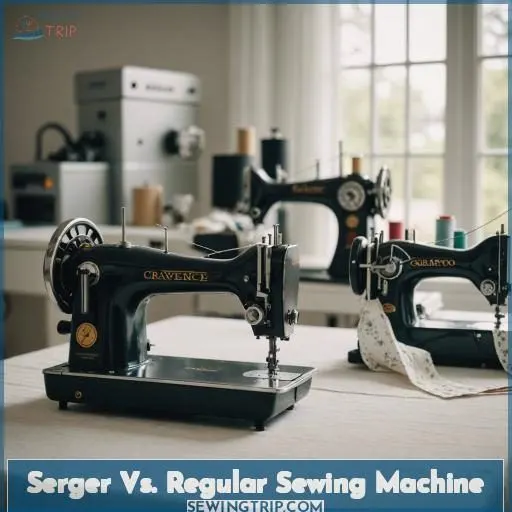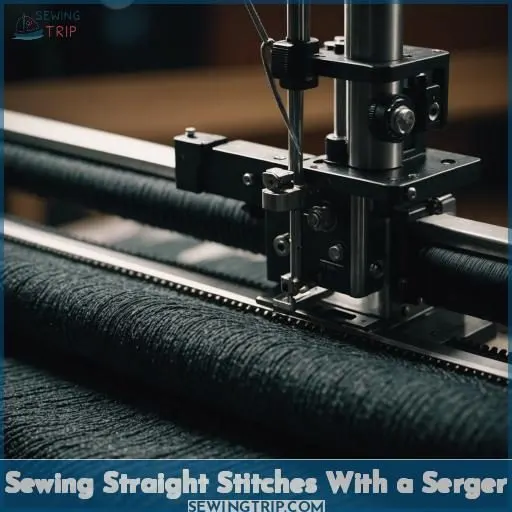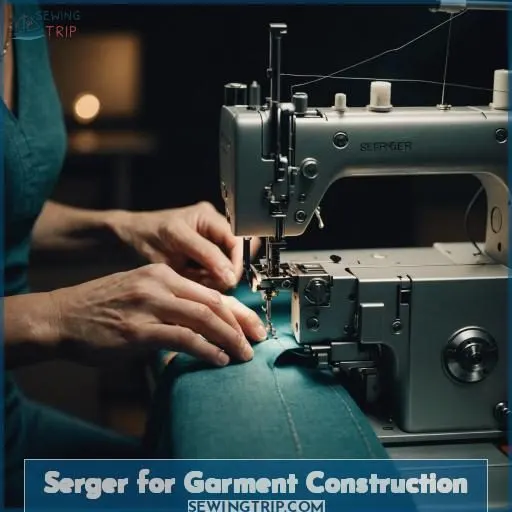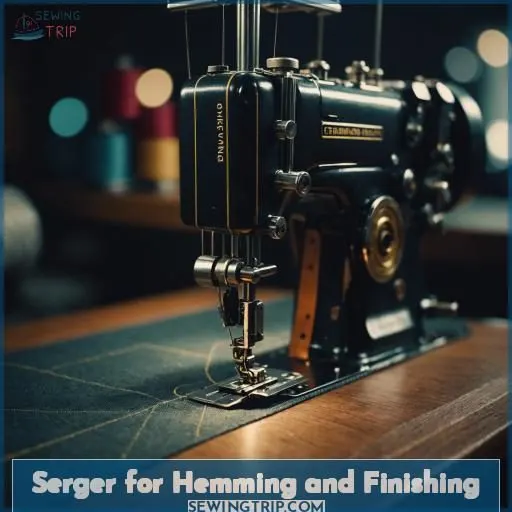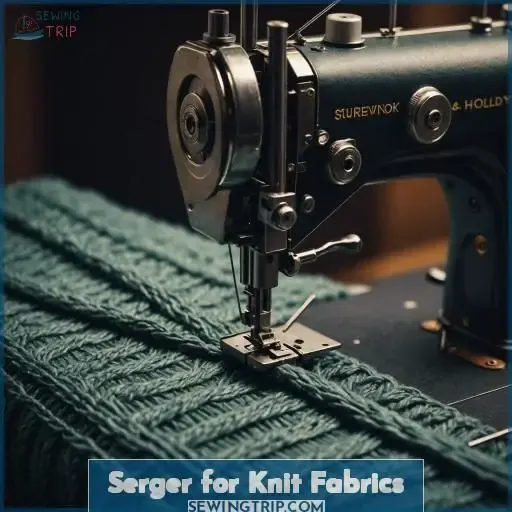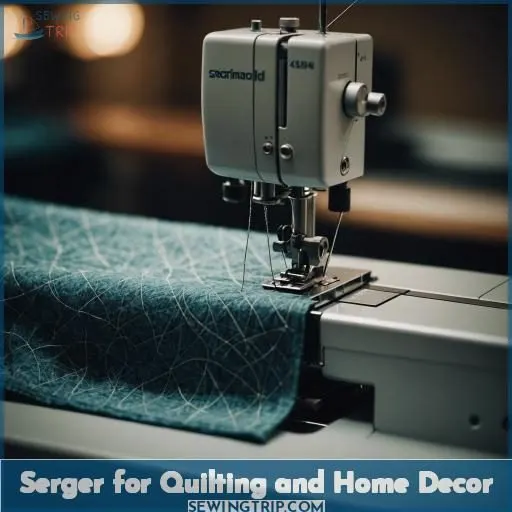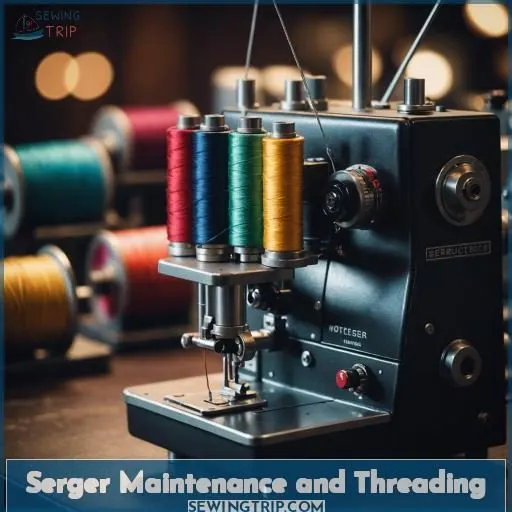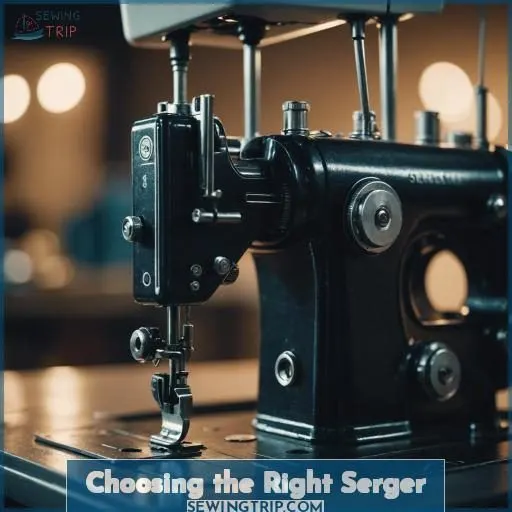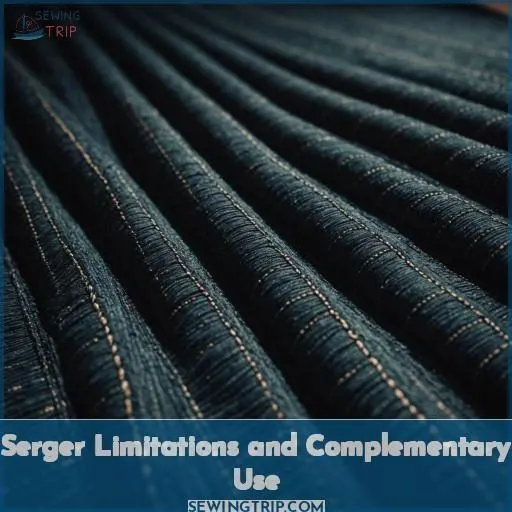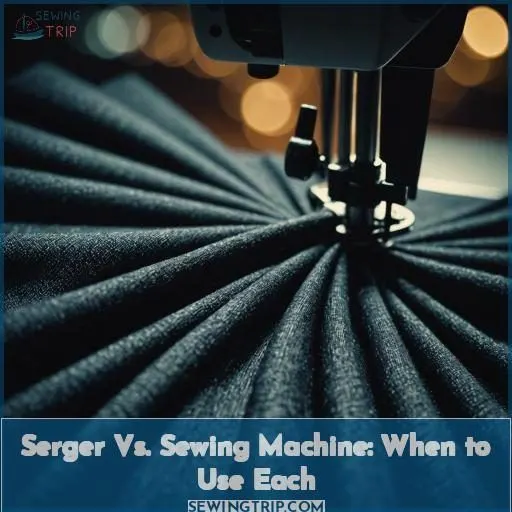This site is supported by our readers. We may earn a commission, at no cost to you, if you purchase through links.
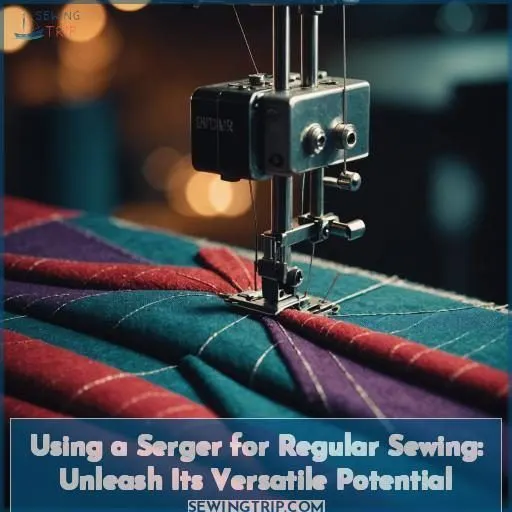 Yes, you can use a serger for regular sewing tasks beyond its core purpose of overlocking seams.
Yes, you can use a serger for regular sewing tasks beyond its core purpose of overlocking seams.
Sergers can sew straight stitches for basic seams, though regular machines excel at intricate straight stitching.
Sergers efficiently join fabric pieces, finish edges, and hem garments with stretchy, durable seams ideal for knits.
They enable creative techniques like decorative edging, embroidery, and rolled hems.
While limited compared to traditional machines in versatility, proper threading and tension maintenance allow sergers to complement your regular sewing routine.
Explore their capabilities to enhance your projects with professional finishes.
Table Of Contents
- Key Takeaways
- Can You Use a Serger for Regular Sewing?
- Serger Vs. Regular Sewing Machine
- Sewing Straight Stitches With a Serger
- Serger for Garment Construction
- Serger for Hemming and Finishing
- Serger for Knit Fabrics
- Serger for Quilting and Home Decor
- Serger Maintenance and Threading
- Choosing the Right Serger
- Serger Limitations and Complementary Use
- Serger Vs. Sewing Machine: When to Use Each
- Frequently Asked Questions (FAQs)
- Conclusion
Key Takeaways
- Sergers can be used for basic seams, finishing edges, and hemming garments, though they lack the versatility of a traditional sewing machine.
- Proper threading, tension adjustment, and maintenance are essential for serger performance and achieving professional results.
- Sergers excel at creating durable, stretchy seams ideal for knit fabrics, but cannot fully replace a sewing machine for detailed stitching, buttonholes, and complex sewing tasks.
- Integrating a serger into your sewing workflow, alongside a regular sewing machine, can unlock new possibilities and enhance your projects with professional-looking finishes.
Can You Use a Serger for Regular Sewing?
Yes, you can use a serger for regular sewing tasks, but with limitations. A serger is primarily designed for finishing seams and edges, not for general construction sewing that requires straight stitches.
Serger Vs. Regular Sewing Machine
While sergers and regular sewing machines share some similarities, their capabilities and features differ markedly. You need to understand the strengths and limitations of each machine to determine when to use a serger for your sewing projects.
Differences in Capabilities and Features
Sergers and regular sewing machines have distinct capabilities. Sergers use multiple threads and loopers to create durable, stretchy seams – perfect for knit fabrics. But they lack the versatility of a sewing machine, which can handle a wider range of fabrics and stitches. Proper threading and tension are key for serger maintenance, while sewing machines require less upkeep.
Strengths and Limitations of Each Machine
While a serger excels at creating durable, stretchy seams and finishing raw edges, it has limitations. It can’t replace a regular sewing machine for detailed stitching, precise control, or complex sewing tasks. However, the two machines complement each other well:
- Sergers are ideal for knits, finishing edges, and fast construction
- Sewing machines excel at straight stitching, buttonholes, and intricate work
- Proper serger threading, tension, and maintenance are essential
- Serger accessories like differential feed expand its versatility
Sewing Straight Stitches With a Serger
Can a serger sew a straight stitch?
The response is affirmative, but with limitations.
Some sergers possess the capacity to produce a straight stitch, frequently termed a chain stitch or mock safety stitch, which may be beneficial for specific applications.
However, it’s crucial to acknowledge that the primary purpose of a serger is to generate overlock stitches, not straight stitches.
Consequently, there are constraints in terms of stitch quality, precision, and versatility when compared to a dedicated sewing machine.
Can a Serger Sew a Straight Stitch?
While a serger can’t fully replace your regular sewing machine, it can be a handy backup for small projects, repairs, and decorative stitches. The serger’s straight stitch, though not as precise as a sewing machine’s, can work well for basic seams on woven fabrics. Beginners may find the serger’s durable, overlocked edges a game-changer for their sewing.
Limitations of Using a Serger for Straight Stitching
While a serger can handle straight stitching, it’s not the ideal tool for the job. Serger needles are designed for overlock stitches, not precise straight stitching. Maintaining proper thread tension can also be tricky. Sergers excel at finishing edges and seams, but lack the control needed for detailed straight stitching. For critical straight stitches, your regular sewing machine remains the better choice.
- Serger needles not optimized for straight stitching
- Maintaining balanced thread tension can be challenging
- Sergers lack the precision control of sewing machines
- Sergers best suited for finishing edges and seams
- Sewing machines remain superior for detailed straight stitches
Serger for Garment Construction
When constructing garments, you can leverage a serger’s capabilities to efficiently join fabric pieces together. Its multiple threads form durable, stretchy seams ideal for constructing knit garments, while its knife trims away excess fabric for neatly finished edges.
Joining Fabric Pieces With a Serger
With your serger, you can easily join fabric pieces together to construct garments. Adjust the thread tension and differential feed to accommodate different fabric types. The serged seam provides a flat, finished edge that’s both durable and stretchy – perfect for knits. Experiment with decorative serger stitches to add a unique touch to your projects.]
Finishing Edges and Seams With a Serger
With a serger, you can effortlessly finish the edges of woven fabrics, trimming away excess material for a clean, professional look. Hemming garments becomes a breeze, and you can even experiment with decorative serging using specialty threads. The serger’s versatility allows you to elevate your regular sewing projects with beautifully finished edges and seams.
- Trim excess fabric for a clean finish
- Hem garments with ease
- Explore decorative serging techniques
- Utilize specialty threads for unique effects
Serger for Hemming and Finishing
You can use a serger to create professional-looking rolled hems quickly and easily, especially on lightweight or sheer fabrics. Furthermore, a serger enables you to incorporate decorative edging or trims to garments and home decor items, enhancing their appearance with minimal effort.
Rolled Hems With a Serger
The serger’s rolled hem feature is a game-changer for hemming projects.
Whether you’re working with lightweight fabrics or stretchy knits, the serger can create a professional-looking rolled hem in a flash.
Just be mindful of its limitations – it cannot replace your regular sewing machine for detailed straight stitching.
But for quick, clean hems, the serger’s rolled hem is hard to beat.
Decorative Edging and Trims
Beyond rolled hems, your serger can create stunning decorative edgings and trims. Stitch on piping, lace insertions, or ribbon trim for a professional finish. Experiment with decorative appliques or bias binding for a unique touch. The serger’s versatility extends to embroidery, darning, and even pattern darning on stretch and woven fabrics, elevating your sewing projects to new heights.
Serger for Knit Fabrics
When working with knit fabrics, you’ll find a serger invaluable for achieving stretchy, durable seams. Its ability to stitch multiple threads simultaneously creates strong, interlocking stitches perfect for accommodating the natural stretch of knits.
Advantages of Using a Serger for Knits
When sewing with knit fabrics, a serger is your hidden advantage. Its multiple threads and specialized stitches create seams with exceptional stretch and durability. The overlocking stitch trims, sews, and finishes edges in one pass, preventing bothersome unraveling. Threading a serger may appear intimidating, but conquering it opens up a realm of opportunities for sewing knits.
Achieving Stretch and Durability in Seams
With a serger, you can create stretchy, durable seams perfect for knit fabrics. Adjust the differential feed to prevent fabric distortion, and experiment with tension settings to achieve the ideal balance. Sergers excel at clean, flat stitches that move with the fabric. Use them for basting, decorative stitches, and even inserting elastic – the possibilities are endless!
Serger for Quilting and Home Decor
Beyond garment construction, a serger can be an invaluable tool for quilting and home decor projects. Its ability to cleanly finish raw edges and create decorative trims allows you to achieve professional-looking results on quilts, pillows, curtains, and other home sewing endeavors.
Finishing Quilt Edges With a Serger
Discover the versatility of your serger by employing it to effortlessly complete quilt edges. Stitch the binding for a polished appearance, or explore creative options for decorative borders. Sergers excel in connecting quilt blocks and embellishing with multiple threads. Regardless of your quilting experience level, your serger is an invaluable tool to enhance your home sewing endeavors.
Serger Applications in Home Sewing Projects
Beyond garment sewing, your serger can elevate home decor projects too. Stitch decorative closures, lace trims, and appliques with ease. Mend worn fabrics with the eye stitch or arrowhead stitch. Craft sturdy tote bags using the flatlock and fishbone stitches. Maximize your serger’s versatility to add professional-looking finishes to all your home sewing creations.
Serger Maintenance and Threading
Correct threading and tension adjustment are essential for a serger’s performance; take the time to follow the manufacturer’s instructions carefully. Regular cleaning and maintenance will guarantee your serger operates smoothly and prevent skipped stitches or thread jamming issues.
Importance of Proper Threading and Tension
Proper threading and tension are essential for your serger’s performance.
Confirm thread compatibility.
Adjust tension dials precisely.
Resolve any problems.
Fabric preparation, such as stabilizing knits, can also affect serger stitching.
Through practice and sewing classes, you’ll become proficient in serger techniques like the raised fishbone stitch for decorative edges.
Your serger’s adaptability opens up new possibilities for sewing projects.
Cleaning and Maintaining a Serger
Maintaining your serger is crucial to maximizing its capabilities.
Regularly clean the machine to prevent thread accumulation and tension imbalances.
Inspect your threading – it’s a frequent contributor to difficulties.
Adjust tension settings as necessary for distinct fabrics.
Replace needles frequently.
Adhere to a scheduled maintenance routine.
With diligent care, your serger will provide exceptional performance for blackwork embroidery and various other applications.
Choosing the Right Serger
When choosing a serger, consider its number of threads, differential feed capabilities, and ease of threading and maintenance. Also evaluate features like the knife system, stitch width adjustment, and built-in stitches to make sure the machine meets your sewing needs.
Factors to Consider When Selecting a Serger
When selecting a serger, take into account the thread types it can handle, from delicate wooly nylon to heavy-duty polyester. Accessory feet like gathering, piping, and blind hemming can broaden its capabilities. Controlling stitch adjustments for tension, differential feed, and stitch length will guarantee professional-looking results. Address issues like skipped stitches, and choose a serger appropriate for your fabric types.
| Serger Feature | Considerations |
|---|---|
| Thread Types | Wooly nylon, polyester, specialty threads |
| Accessory Feet | Gathering, piping, blind hemming |
| Stitch Adjustments | Tension, differential feed, stitch length |
| Troubleshooting | Skipped stitches, fabric compatibility |
| Fabric Compatibility | Knits, wovens, delicates, heavy-weight |
Comparing Features and Capabilities
When choosing a serger, consider:
Its thread tension controls
Its stitch length adjustability
Its presser foot options
Match the needle size to the fabric type you’ll be sewing.
Look for a serger with:
Easy-to-use tension dials
Clear stitch length markings
Versatile presser feet allow you to handle a variety of fabrics with ease.
These features will help you get the most out of your serger.
Serger Limitations and Complementary Use
While a serger is incredibly versatile and can handle many tasks, you can’t completely replace a regular sewing machine with it. You’ll need to integrate a serger into your sewing workflow alongside your primary machine, utilizing each tool’s strengths to their full potential.
Tasks a Serger Cannot Replace a Regular Machine For
While a serger is a powerful tool, it cannot fully replace your trusty sewing machine.
Sergers excel at finishing edges and seams.
However, they lack the versatility to handle detailed sewing tasks like zippers, buttonholes, and precise topstitching.
Think of your serger as a specialized sidekick.
It is great for speeding up garment construction.
Yet, your regular machine is still the workhorse for all-around sewing.
Integrating a Serger Into Your Sewing Workflow
While a serger excels at creating durable, stretchy seams, it’s not a one-stop-shop for all your sewing needs. Integrate your serger into your workflow by using it for repairs, embellishments, and crafts, but rely on your regular sewing machine for precise stitching, buttonholes, and lace insertion. Harnessing the capabilities of both machines will unleash boundless sewing possibilities.
Serger Vs. Sewing Machine: When to Use Each
You’ll want to choose a serger when working with knit fabrics or creating stretchy, durable seams, while a regular sewing machine excels at tasks like precise stitching, pivoting, letting out seams, and sewing detailed or complicated designs.
Scenarios Where a Serger is the Better Choice
With regard to serging versus traditional seams, a serger excels. Its capacity to produce decorative finishes and manage stretchy fabrics makes it suitable for garment construction. Sergers also excel at repairing, as their strong stitches reinforce damaged areas. For embellishments like rolled hems and decorative edging, a serger is your designated machine.
Situations Where a Regular Sewing Machine is Preferred
You’ll need your regular sewing machine for tasks like topstitching, bartacks, felled seams, and blind hems where a precise lockstitch is required.
While a serger can construct stretchy seams, it can’t replace the versatility of a sewing machine for tailoring tasks.
For example, you can’t let out serged seams or pivot as easily for collar points and facings.
A sewing machine reigns supreme for detailed sewing that demands precision.
Frequently Asked Questions (FAQs)
Can you just sew with a serger?
You can’t fully rely on a serger alone. It’s designed for edge finishing and basic seams, not detailed sewing. Invest in both machines—a serger streamlines, but a sewing machine handles intricate tasks with ease.
Can you sew a straight stitch with a serger?
No, you can’t. But wait, there’s more…A serger cuts fabric while creating an overlocked seam. It’s lightning-fast for finishing knits but lacks the finesse for elegant stitches. Still, explore its full potential—it’ll surprise you with decorative flair!
Can you use a serger for everything?
No, you can’t use a serger for everything. While it’s great for seams and edges, it lacks the versatility of a regular sewing machine. Invest in both for the full sewing experience.
Why use a serger instead of a sewing machine?
You’d use a serger to quickly finish seam allowances and garment edges with professional-looking overlock stitches. It creates stretchy, durable seams ideal for knits.
Can a serger be used for embroidery?
Just like a wave crashing against the shore, a serger simply isn’t designed for embroidery. Its interlocked stitches offer strength, but lack artistry – best suited for seams or edging tasks.
How do I adjust the tension on a serger?
To adjust serger tension, consult your manual. First, refer to your threading guide. Then, use the tension dials to loosen or tighten threads as needed. Test stitches on scraps until balanced.
Can a serger sew buttonholes?
Unfortunately, no. A serger can’t sew buttonholes. Its specialty is creating overlock stitches, perfect for stretchy seams on knits and neatly finishing fabric edges. For buttonholes, you’ll need your regular sewing machine.
How do I clean and maintain a serger?
Clean regularly – brush lint off, use canned air for dust/thread bits. Oil per manufacturer’s guide. Tension loosen/re-thread when switching thread types. Master threading – it’s an art. With care, your serger will purr, create perfect seams.
Can a serger sew leather or vinyl?
Ah, the allure of leather and vinyl! While a serger’s sharp stitch may seem tempting for these materials, alas, its blades would dull quickly – better opt for a heavy-duty machine to tackle such resilient fabrics with finesse.
Conclusion
Harness the versatile potential of your serger alongside your regular sewing machine.
While it can’t substitute certain intricate tasks, proper threading and tension maintenance enable you to achieve professional finishes with decorative edging, durable seams for knits, and efficient garment construction.
Incorporate this complementary tool into your sewing workflow, leveraging its strengths to enhance your projects with stretchy, rolled hems and beautifully overlocked seams.
Experiment with employing a serger for regular sewing to uncover its capabilities beyond the primary purpose of overlocking.

